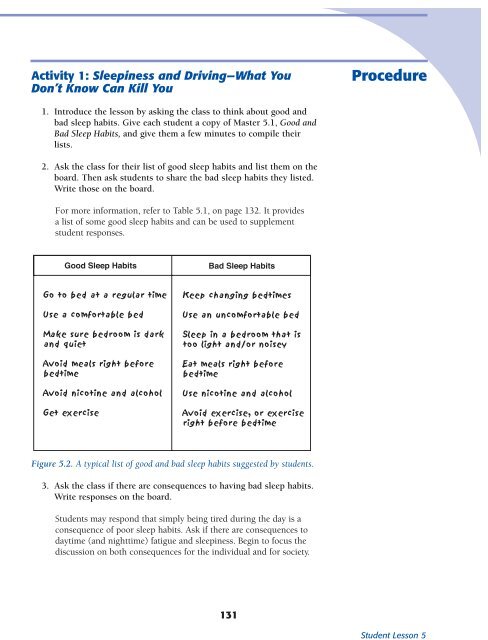- Page 1 and 2:
Sleep, Sleep Disorders, and Biologi
- Page 3 and 4:
BSCS Development Team Rodger Bybee,
- Page 5 and 6:
3.5 Biological clock . . . . . . .
- Page 8:
About the National Institutes of He
- Page 12 and 13:
Introduction to Sleep, Sleep Disord
- Page 14 and 15:
Implementing the Module The six les
- Page 16 and 17:
Content Standards: Grades 9-12 Stan
- Page 18 and 19:
Teaching Standards The suggested te
- Page 20 and 21:
shot” of what the students unders
- Page 22 and 23:
What the Students Do Stage Engage E
- Page 24 and 25:
Using the Student LessonsL The hear
- Page 26 and 27:
Using the Web Site The Sleep, Sleep
- Page 28:
to and use of information and data
- Page 31 and 32:
Sleep, Sleep Disorders, and Biologi
- Page 33 and 34:
Sleep, Sleep Disorders, and Biologi
- Page 35 and 36:
Sleep, Sleep Disorders, and Biologi
- Page 37 and 38:
Sleep, Sleep Disorders, and Biologi
- Page 39 and 40:
Sleep, Sleep Disorders, and Biologi
- Page 41 and 42:
Sleep, Sleep Disorders, and Biologi
- Page 43 and 44:
Sleep, Sleep Disorders, and Biologi
- Page 45 and 46:
Sleep, Sleep Disorders, and Biologi
- Page 47 and 48:
Sleep, Sleep Disorders, and Biologi
- Page 50 and 51:
Glossary amplitude: Magnitude, grea
- Page 52 and 53:
References 1. Aserinsky, E. 1999. E
- Page 54 and 55:
Sleep Diary Pre-lesson Activity Eng
- Page 56 and 57:
tions, medications, or drugs affect
- Page 58 and 59:
Pre-lesson Organizer Pre-lesson Act
- Page 60 and 61:
Recording Bedtimes and Wake Times I
- Page 62:
Calculating Average Bedtime and Wak
- Page 65 and 66:
Sleep, Sleep Disorders, and Biologi
- Page 67 and 68:
Sleep, Sleep Disorders, and Biologi
- Page 69 and 70:
Sleep, Sleep Disorders, and Biologi
- Page 71 and 72:
Sleep, Sleep Disorders, and Biologi
- Page 73 and 74:
Sleep, Sleep Disorders, and Biologi
- Page 75 and 76:
Sleep, Sleep Disorders, and Biologi
- Page 77 and 78:
What Do You Know (or Think You Know
- Page 79 and 80:
FALSE 9. The body quickly adjusts t
- Page 81 and 82:
Sleep, Sleep Disorders, and Biologi
- Page 83 and 84:
Sleep, Sleep Disorders, and Biologi
- Page 85 and 86:
Sleep, Sleep Disorders, and Biologi
- Page 87 and 88:
Sleep, Sleep Disorders, and Biologi
- Page 89 and 90:
Sleep, Sleep Disorders, and Biologi
- Page 91 and 92: Astronaut Telemetry Evaluation Form
- Page 93 and 94: Astronaut Rodriquez Respiration: Bo
- Page 95 and 96: Sleep Medicine Reference Manual SLE
- Page 97 and 98: Hypnograms Hypnograms were develope
- Page 99 and 100: Sleep, Sleep Disorders, and Biologi
- Page 101 and 102: Sleep, Sleep Disorders, and Biologi
- Page 103 and 104: Sleep, Sleep Disorders, and Biologi
- Page 105 and 106: Sleep, Sleep Disorders, and Biologi
- Page 107 and 108: Sleep, Sleep Disorders, and Biologi
- Page 109 and 110: Michel Siffre Story How did you cel
- Page 111 and 112: Sleepiness Scale Graph Template Nam
- Page 114 and 115: Evaluating Sleep Disorders Lesson 4
- Page 116 and 117: Preparation Activity 2 Students wil
- Page 118 and 119: Question 6. Have you, or a member o
- Page 120 and 121: Key aspects of case studies and ans
- Page 122 and 123: 3. How would you suggest that this
- Page 124 and 125: ANSWERS TO DISCUSSION QUESTIONS 1.
- Page 126 and 127: Lesson 4 Organizer Activity 1: Snor
- Page 128 and 129: Snoring—Believe It or Not! A burg
- Page 130 and 131: Case History 1 Case History 1 Prima
- Page 132 and 133: Case History 3 Case History 3 Prima
- Page 134 and 135: Case History 5 Case History 5 Prima
- Page 136 and 137: Sleep Disorders Reference Manual In
- Page 138: Treatments: Those suffering from sl
- Page 141: Sleep, Sleep Disorders, and Biologi
- Page 145 and 146: Sleep, Sleep Disorders, and Biologi
- Page 147 and 148: Reconvene the class and have each s
- Page 149 and 150: Newspaper Articles The Gotham Daily
- Page 152: Additional WebW Resources for Teach
- Page 155 and 156: Sleep, Sleep Disorders, and Biologi
- Page 158: Appendix III More About the Nationa

















